Ginger Bug is a liquid culture full of beneficial probiotics made from fresh ginger, sugar, and water. It's easy to make, taking a week or less. Then it can be used to craft homemade ginger ale, sarsaparilla, fruit-flavored sodas, tonics, and more all teeming with natural carbonation.
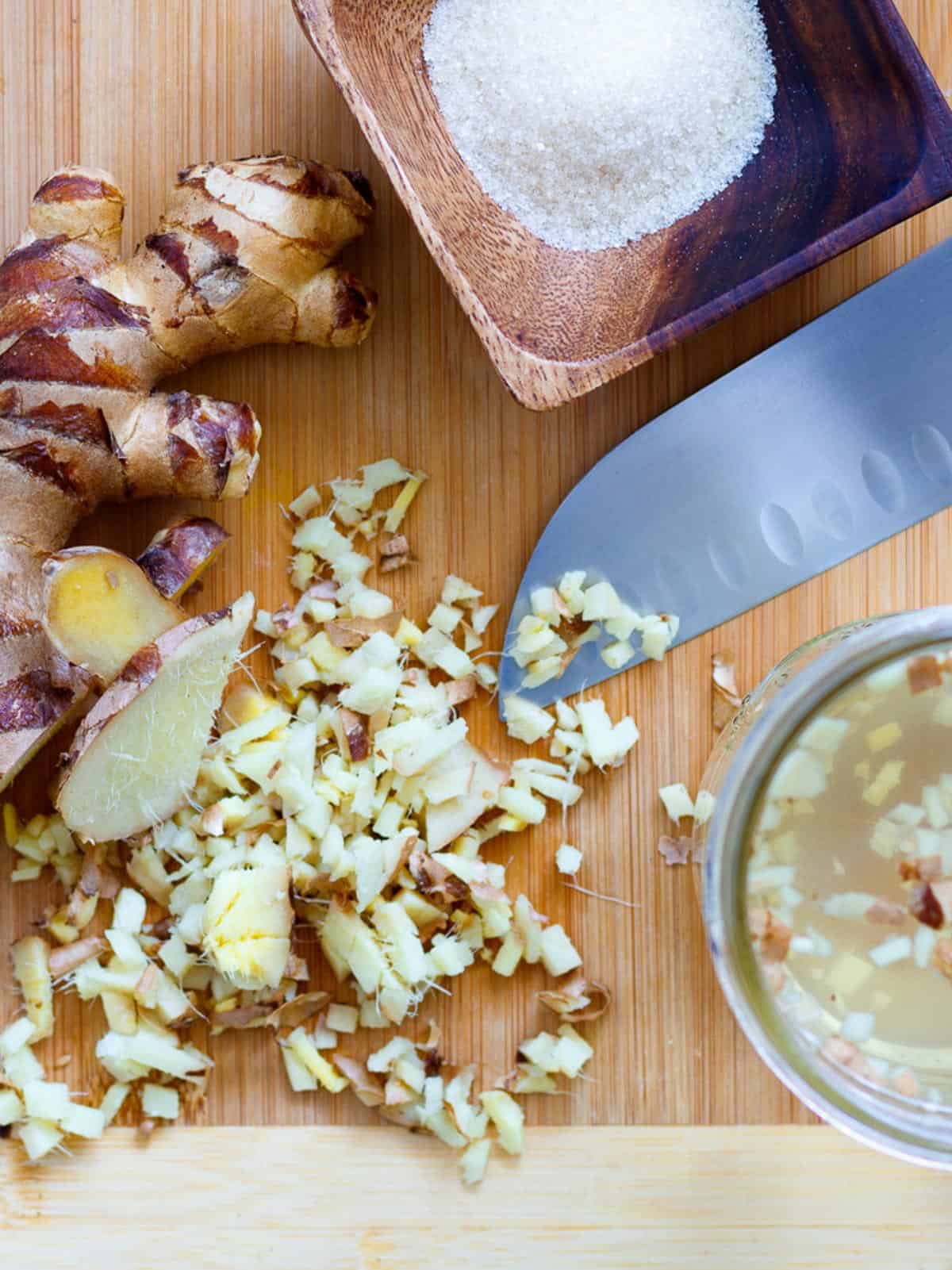
Once you have your wild ferment, it can be kept alive indefinitely. I've lost track of how long I've had my faithful culture in the refrigerator.
I am going to guess it's been well over 2 years. Just imagine, all I have had to do is feed it periodically. As a result, we have been rewarded with countless bottles and flavors of refreshing homemade soda.
Jump to:
Why make a ginger bug
- Probiotics
- Easy to maintain
- Use to make naturally carbonated sodas
- Refeshing sparkly drinks in 24 hours, unlike kombucha that takes weeks to brew and become fizzy.
Ingredients
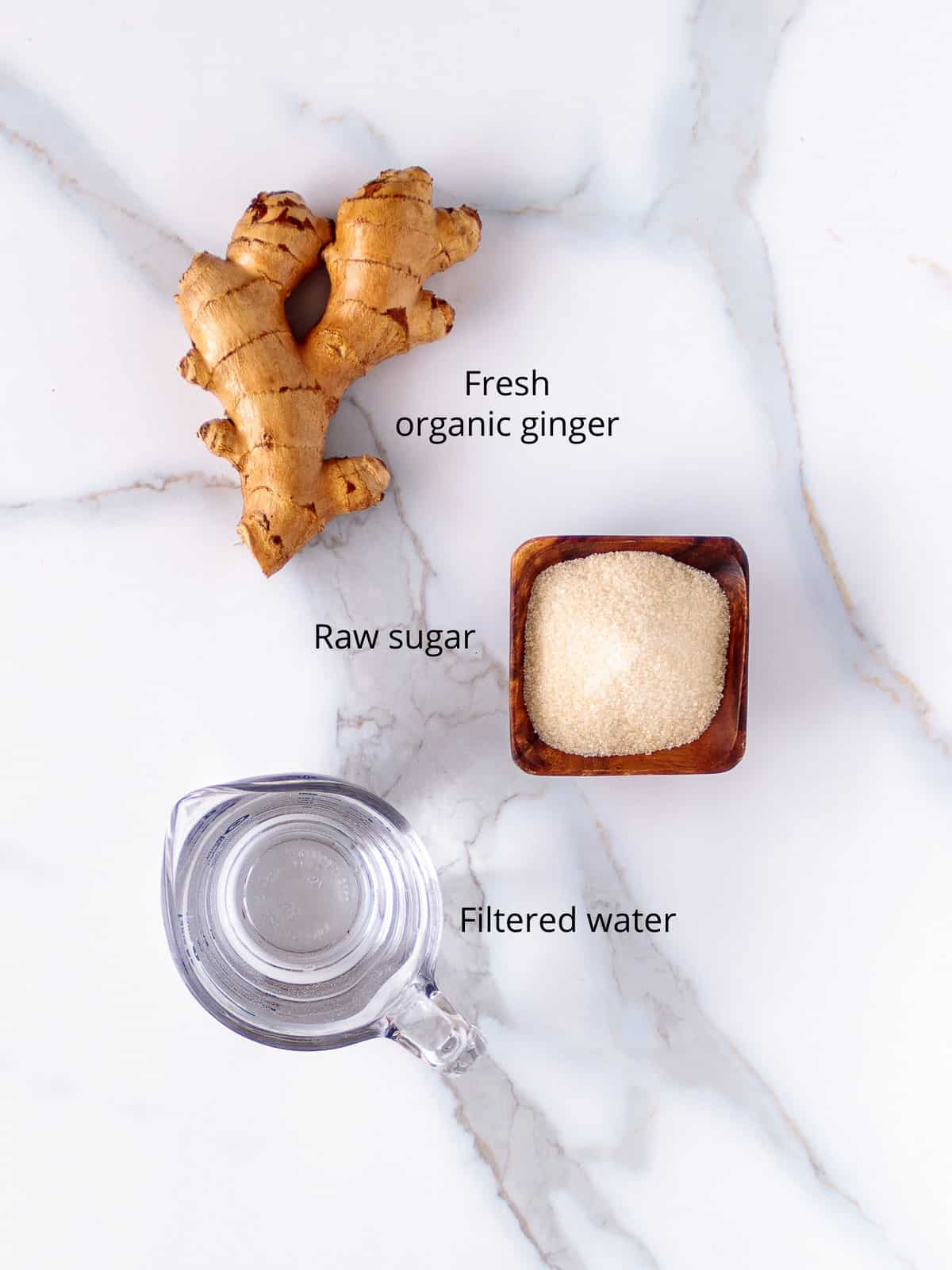
- Ginger - Organic is best. Look for crisp, firm ginger without any traces of mold.
- Raw sugar - Organic granulated cane sugar from evaporated sugar cane juice.
- Water - Filtered or bottled spring water without any chlorine or additives.
Equipment
It's amazing you can make a wild yeast miracle with such simple equipment. You don't need anything fancy and the rubber band is probably the hardest thing you'll have to hunt down.
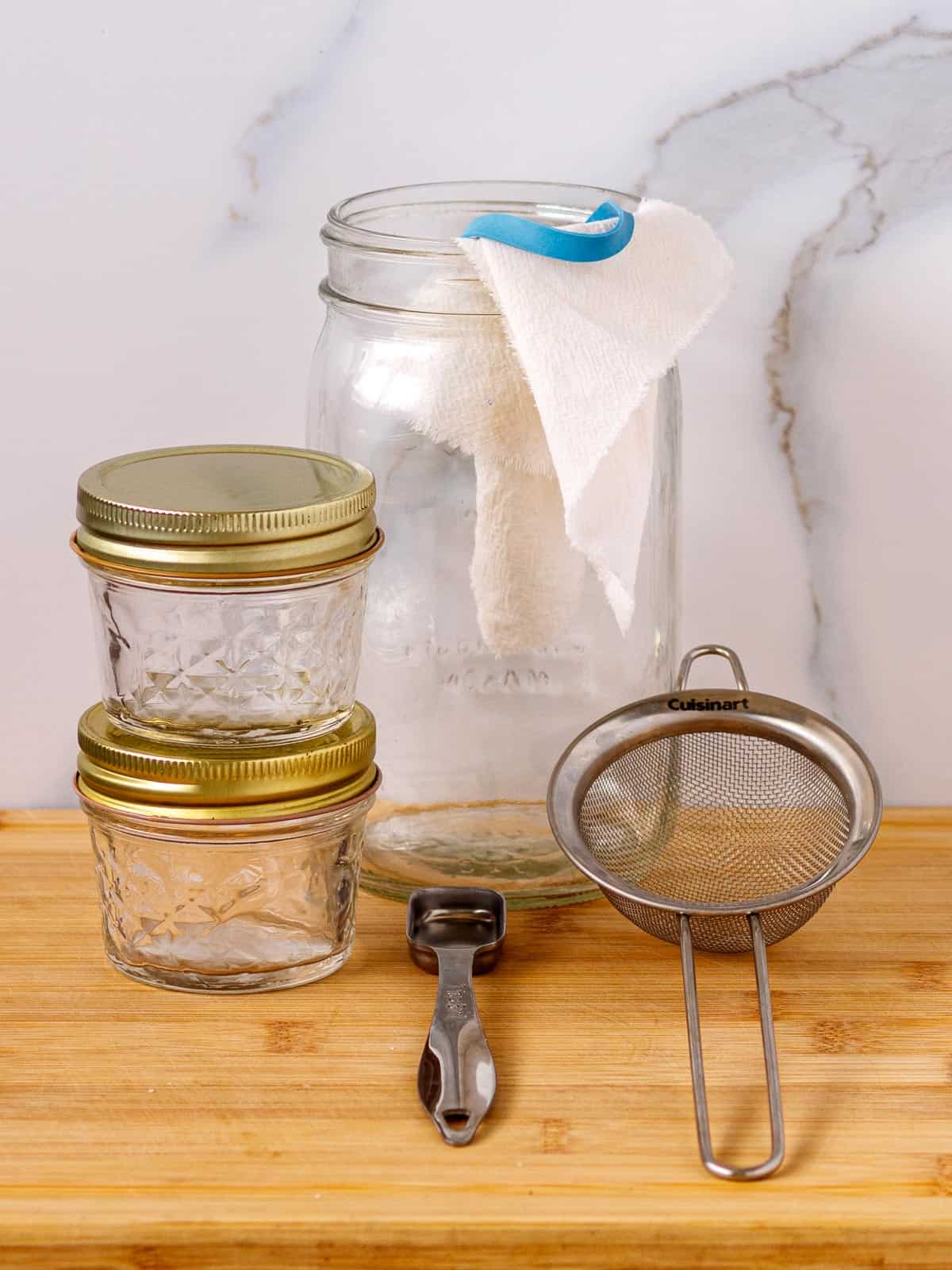
- One quart jar and two smaller jars with lids.
- One six-inch square of breathable cotton cloth.
- Sturdy rubber band.
- Small strainer and teaspoon measure.
Step by step
How to make it

- Leave skin on and chop ginger.
- Measure chopped ginger, raw sugar and filtered water.
- Place all three in a jar and stir.
- Cover jar with cloth and a rubber band.
How to ferment it
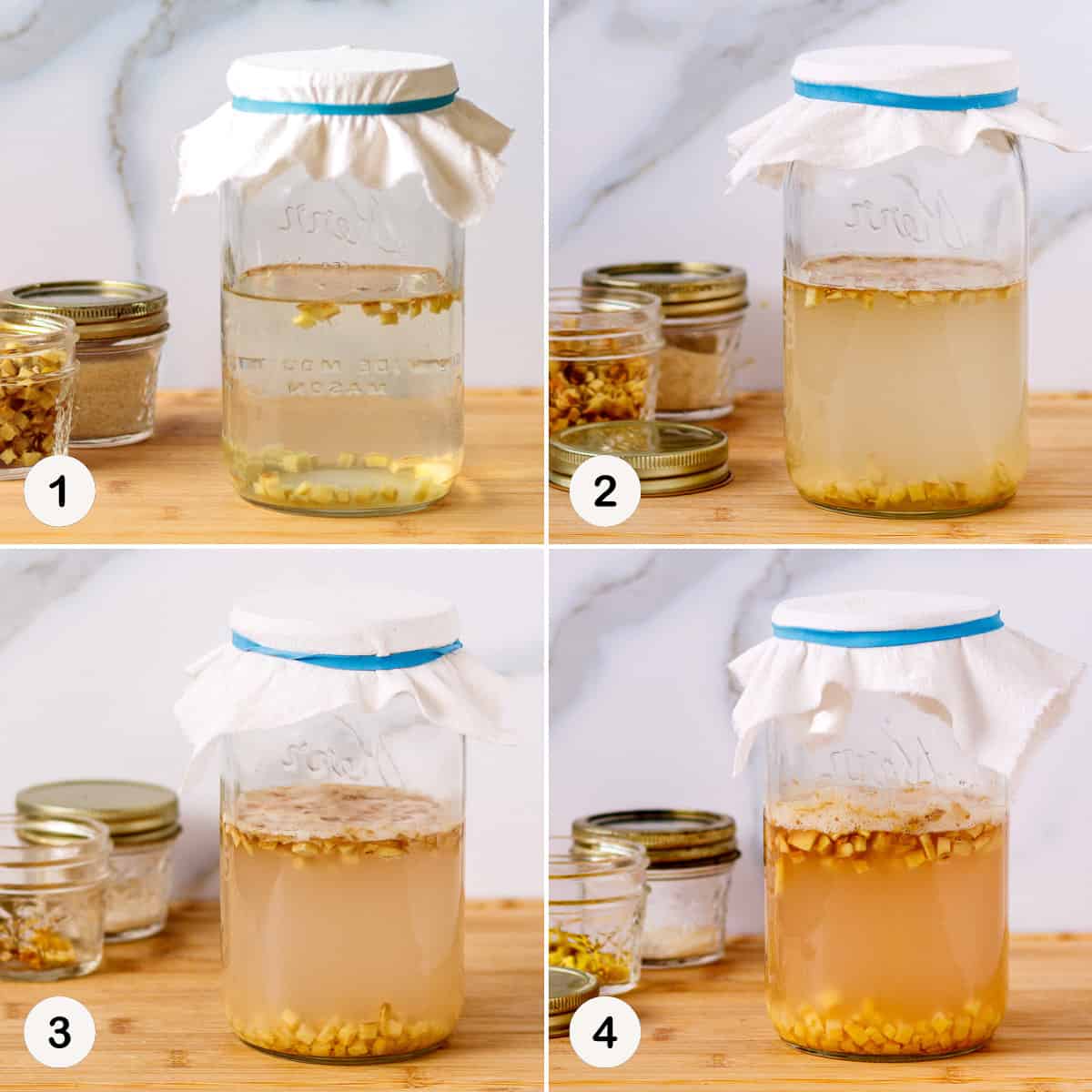
- Day one - let sit at room temperature and feed at the end of 24 hours.
- Days two to three - continue feeding on schedule.
- Days four to five - feed and watch for some of the signs listed below.
- Days six to seven - Look for all of the signs listed below confirming your starter is ready to use.
The time it takes for your culture to mature varies depending on the climate and natural microorganisms in your environment.
Keep in mind the timing is not an exact science, but use this feeding schedule and expect your probiotic mixture to be ready anywhere from 3 to 10 days.
When is it ready?
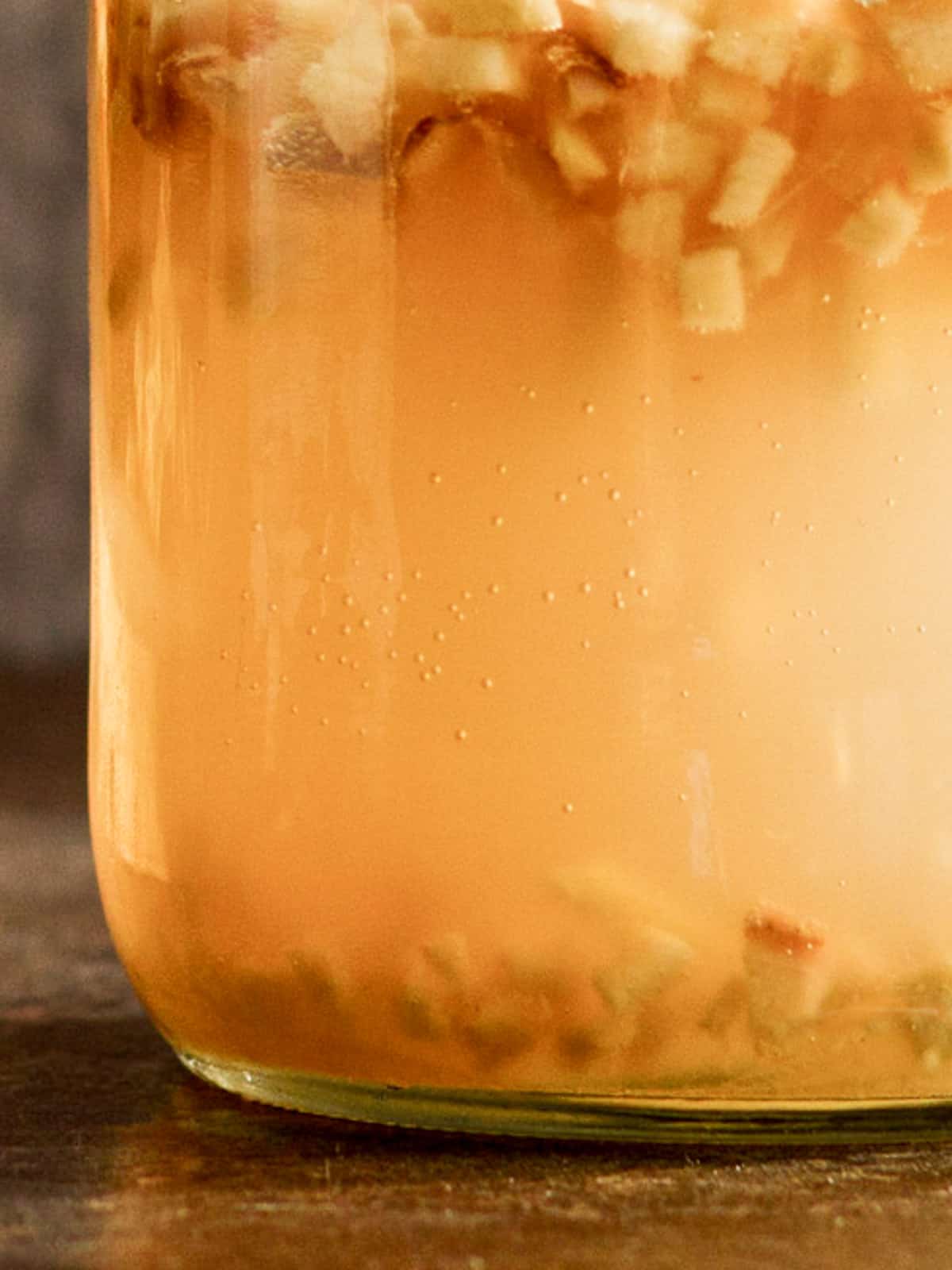
You can use your senses to get to know your ginger bug. Then, the otherwise elusive signals that your starter is ready are clear. Look for all of these markers.
- Sight - Liquid changes from clear to opaque and darkens. Ginger pieces float up and accumulate at the surface. There will be tiny bubbles, but don't worry if they are hard to see. A foamy top with larger bubbles will show on the top. Also, look for sediment building at the bottom of the jar.
- Smell - A ripe ferment smells clearly of ginger with a more subtle yeasty or slightly soapy smell.
- Sound - When you feed your starter, give it a good stir and put your ear closer to the jar. You can actually hear the tiny bubbles fizzing.
- Taste - Yes, go ahead it's safe to taste it. Just use a clean spoon and don't dip it back in after you have used it. A ready culture tastes sharp and gingery. It will be both sweet and tangy like a mild lemonade.
How to use
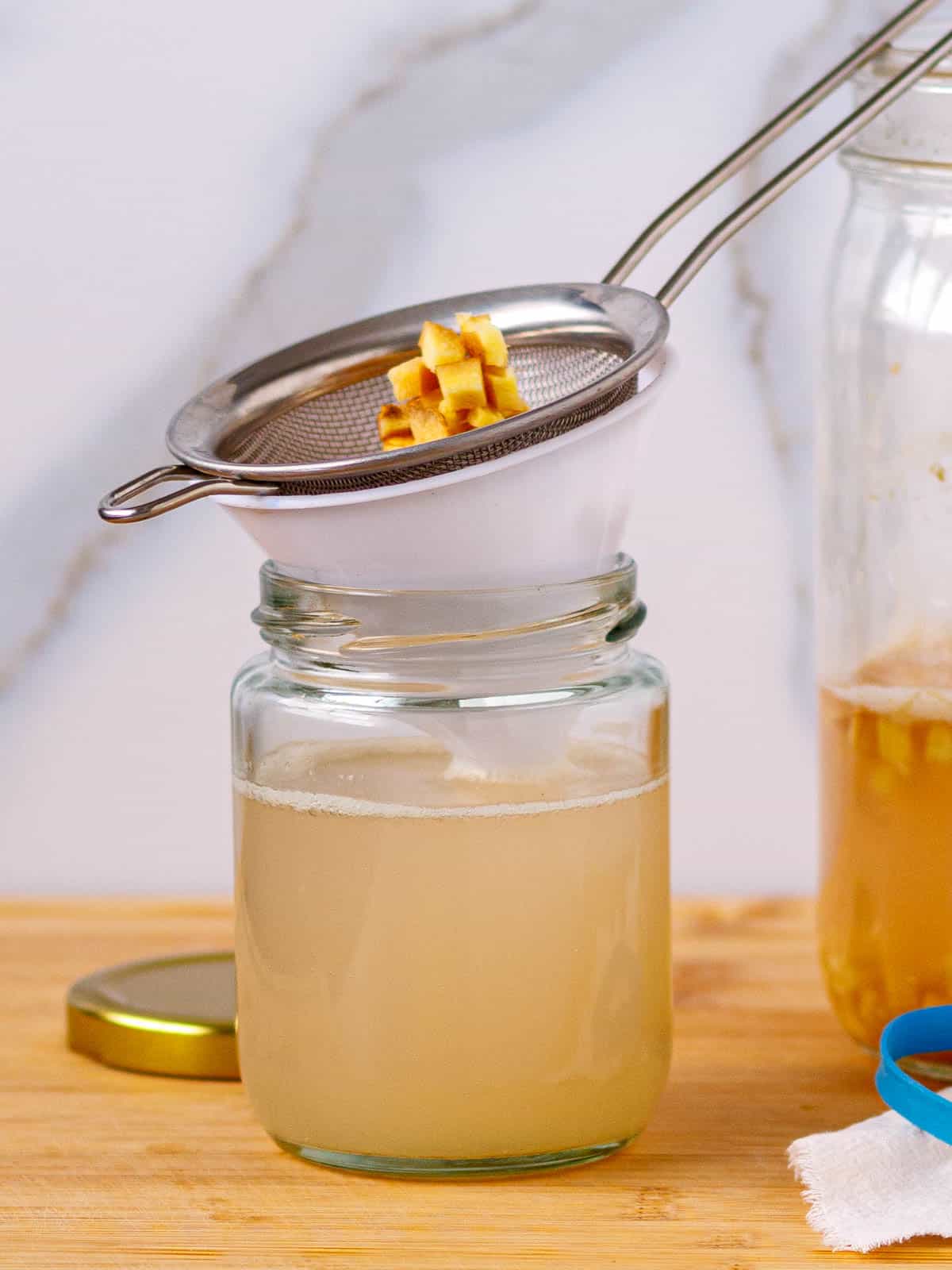
Using a ginger bug to make lively bubbling beverages is simple and straightforward. All you need to do is strain your healthy brew and add the measured amount called for in your recipe.
Some of the drinks you can make with it are sparkling teas, natural fruit sodas, dry ginger ale, herbal tonics, and festive holiday beverages.
How to maintain
Just like a sourdough starter, this amazing brew full of beneficial bacteria lasts indefinitely if stored and fed regularly.

- Once your ferment is complete, strain off all the chopped ginger and toss it out. Transfer the liquid to a clean jar. Add one tablespoon each of sugar and fresh ginger.
- Stir your mixture and place the lid on the jar. Put it in your refrigerator and feed your culture once a week.
The recipe below has everything you need to create your first ginger bug. After that, you can look forward to making Homemade Ginger Ale.
The best-tasting homemade ginger ale you've ever had is just the start of what you can do with this recipe.
From there, you can move on to endless flavor options. Some of the favorite varieties in our house are tamarind, pineapple, elderberry, and grape soda.
Is ginger bug good for you?

If you can handle a little sugar, this recipe will give you a sparkling refreshment that has a justification for its indulgence.
When ginger and sugar ferment together, it creates gut-healthy probiotics. Those microorganisms continue to grow when you use them to make beverages with natural sweeteners.
In the same way the beneficial bacteria in kombucha, yogurt, and kimchee aid digestion, natural sodas made with ginger bug culture support a healthy gut.
I reserve my soda sipping for special occasions and never experience unpleasant effects from the modest amount of sugar.
In my book, the pure pleasure and joy from these ginger-bug sodas combined with helpful microbes feed my overall health.
You can even use unsweetened concentrated fruit juice if you want in place of added sugars when crafting sodas at home.
It seems almost too good to be true when you pop open a swing-top bottle, and all those bubbles rush to the top.
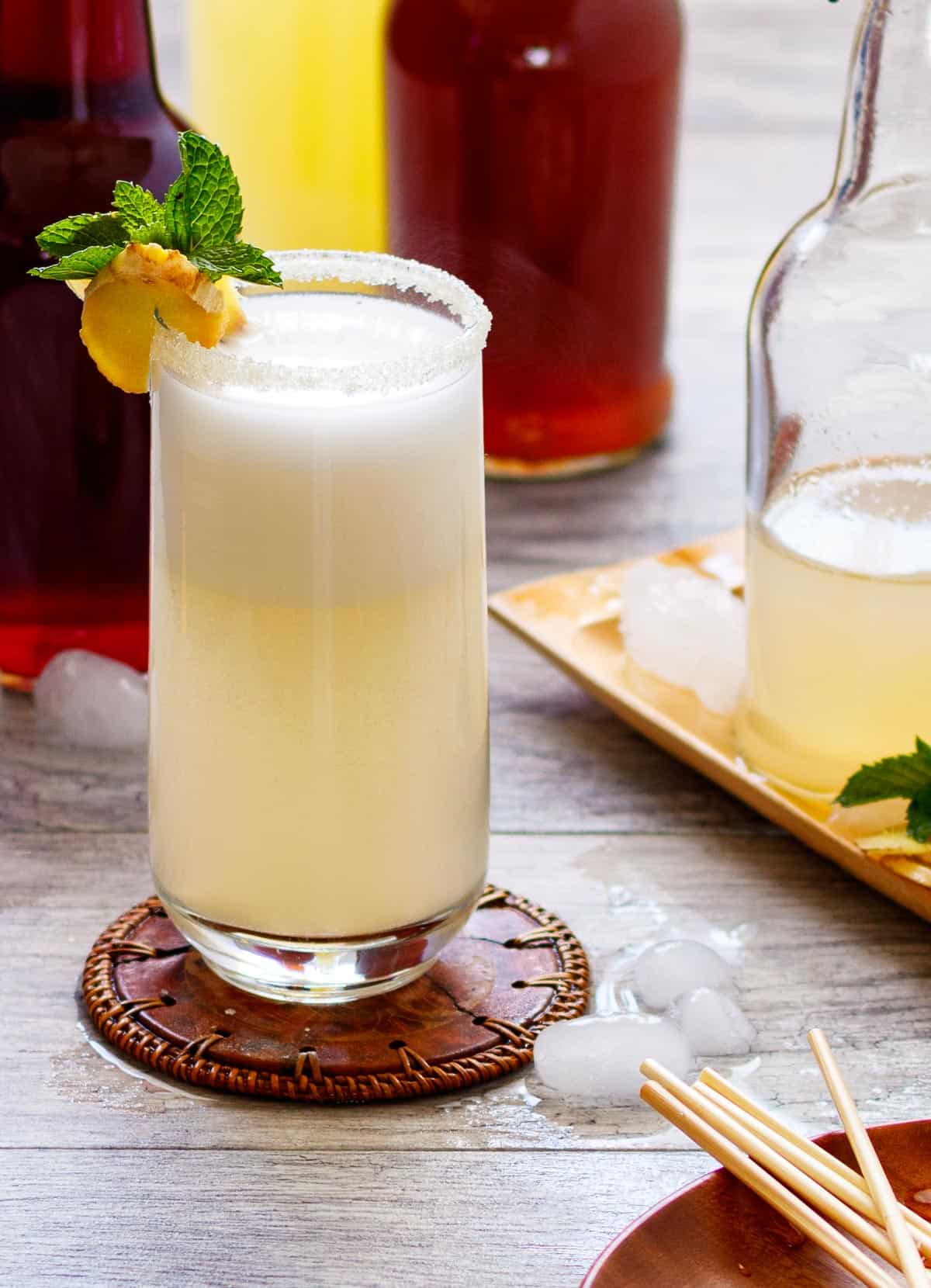
Expert tips
Ingredients
- Use filtered water without chlorine or water bottled without additives.
- You can use peeled ginger, but I recommend leaving the skin on for convenience. The extra bacteria in the skin is helpful.
Equipment
- Make sure your equipment is sterilized or very clean.
- Use a jar large enough to provide some air space while fermenting.
- Cover your jar with a breathable cotton cloth and keep it out of direct sunlight.
Preparation
- It's not necessary to grate the ginger. Diced small is fine.
- Chop all your ginger in advance.
- Store ginger and sugar for the weeks feeding in small jars. (Refrigerate the ginger.)
- Don't overfeed your mixture. It needs time to digest the fresh sugar and ginger.
Maintaining
- Mark your jar with the date when you first put it in the refrigerator to store.
- Each time you remove some liquid to brew soda, replenish with an equal amount of water, and feed the starter.
- If you have a ginger bug that has been in the refrigerator for several weeks, you can "wake" it up. Strain out the old ginger pulp and feed it with 1 tablespoon each of ginger and sugar. Place it at room temperature for 12- 24 hours to ferment before making your soda.
- Over time the chopped ginger will accumulate. Go ahead and strain it all out and toss it away. Add a tablespoon each of sugar and ginger and replenish water if needed.
FAQ
If you have stored it in the refrigerator, it's likely still fine for up to a month or more. Just start feeding it again daily at room temperature and look for the signs listed in this post after a few days.
No. A ginger plant is a symbiotic culture that looks like small translucent grains. A true ginger plant has been carefully preserved over time and is not made from baker's yeast or brewer's yeast like some substitute ginger plants are. If you would like to take on making ginger beer, you can purchase a genuine ginger plant from Yemoos Nourishing Cultures.
Some of the reasons for a failed ferment are water with chlorine, contaminated containers, mold spores on ginger, other cultures like sourdough nearby, and direct sunlight or too high a temperature. If you have fed your bug regularly and it smells bad, has mold, or doesn't show any signs of activity after 5-6 days, throw it out and start over.
More cultured and fermented recipes
Enjoyed this post? Leave a comment, rate ⭐⭐⭐⭐⭐ it, and follow @poppyswildkitchen on Instagram. Aloha!
📖 Recipe

Ginger Bug Recipe
Ingredients
Start Ginger Bug
- 2 cups filtered or bottled spring water
- 1 tablespoon organic ginger chopped in ⅛ inch pieces
- 1 tablespoon organic raw cane sugar
For Feeding
- ¼ cup chopped ginger
- ¼ cup organic raw cane sugar
Instructions
Prep ginger
- Wash whole ginger and dry with a clean paper towel. Leave skin on and chop ginger into ⅛-inch pieces. You can chop all the ginger in advance and keep it in the refrigerator to use each day as needed.
Start Ginger Bug
- Pour 2 cups filtered or bottled spring water into a one-quart jar. Add 1 tablespoon organic ginger and 1 tablespoon organic raw cane sugar. Stir to mix. Cover the jar with a square of breathable cotton cloth cut to size. Secure with a rubber band. Set aside at room temperature out of direct sunlight. A countertop or table is fine.
Daily Feeding
- Every day, remove the cover from the jar and add 2 teaspoons each raw sugar and chopped ginger. You'll need a total of ¼ cup chopped ginger and ¼ cup organic raw cane sugar for a week of feeding. Give a quick stir and replace the cover. Don't overfeed your ginger bug. It needs time to digest and convert sugar.
- In a couple of days the ginger bug may show bubbles or signs of fizziness. Don't worry if you don't see obvious signs. Your culture is working behind the scenes growing beneficial probiotics. If your culture grows mold or smells bad, toss it out and start over.
- After 4-7 days your healthy culture will be ready. If you aren't sure, just give it the full 7 days to ferment.
- Strain your ginger bug into a clean jar and toss away all the old ginger. Now you can use it to make homemade, naturally carbonated sodas.
- Once you have measured out the needed ginger bug to make your first soda, replace the liquid with an equal amount of filtered water and add 1 tablespoon each of finely chopped ginger and raw sugar.
Store
- Store your freshly fed ginger bug in the refrigerator and feed it one tablespoon each of chopped ginger and raw sugar every week.
Notes
- Use filtered water without chlorine or water bottled without additives.
- You can use peeled ginger, but I recommend leaving the skin on for convenience. The extra bacteria in the skin is helpful.
- Make sure your equipment is sterilized or very clean.
- Use a jar large enough to provide some air space while fermenting.
- Cover your jar with a breathable cotton cloth and keep it out of direct sunlight.
- It's not necessary to grate the ginger. Diced small is fine.
- Chop all your ginger in advance.
- Store ginger and sugar for the weeks feeding in small jars.
- Don't overfeed your mixture. It needs time to digest the fresh sugar and ginger.
- The first time you put your ginger bug in the refrigerator, mark the date on the jar.
- Each time you remove some liquid to brew soda, replenish with an equal amount of water, and feed the starter.
- If you have a ginger bug that has been in the refrigerator for several weeks, you can "wake" it up. Strain out the old ginger pulp and feed it with 1 tablespoon each of ginger and sugar. Place it at room temperature for 12- 24 hours to ferment before making your soda.
- Over time the chopped ginger will accumulate. Go ahead and strain it all out and toss it away. Add a tablespoon each of sugar and ginger and replenish water if needed.

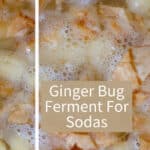

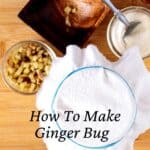
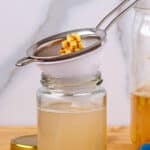

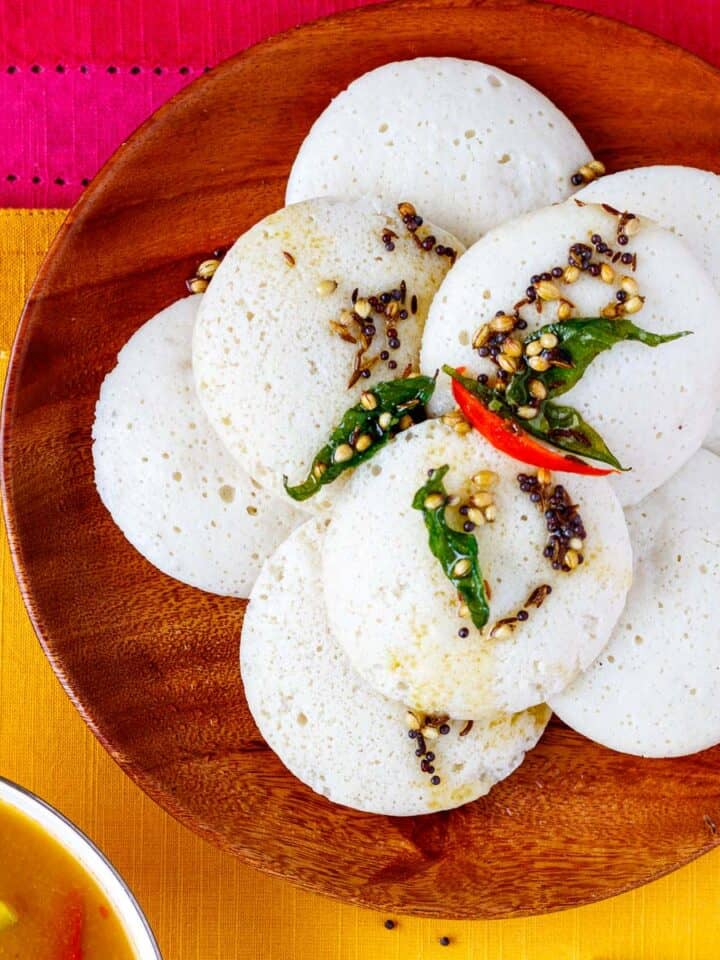
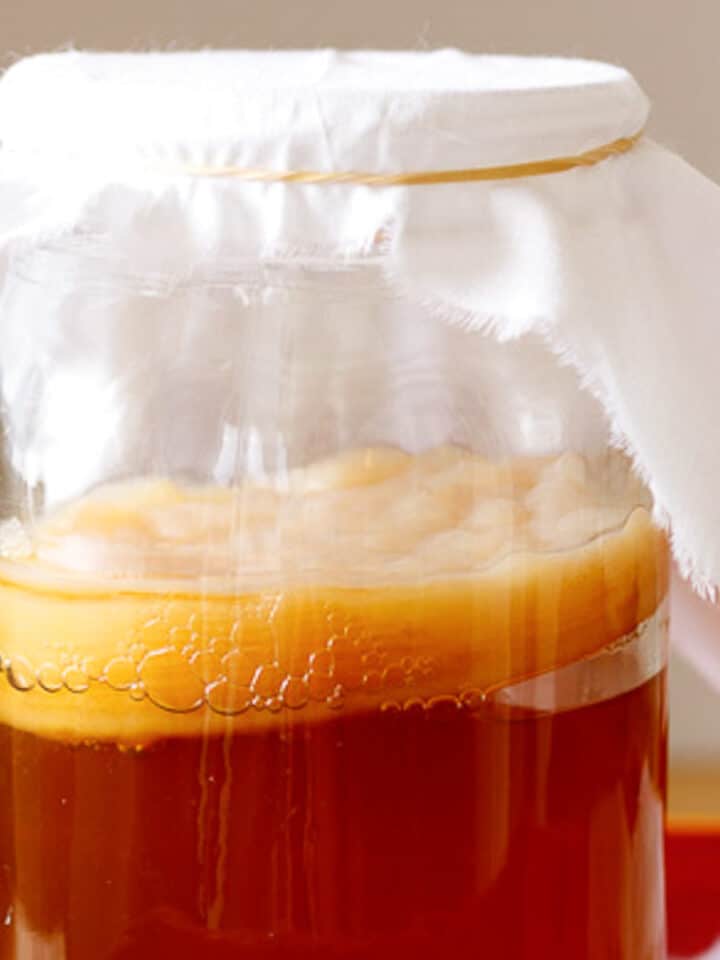

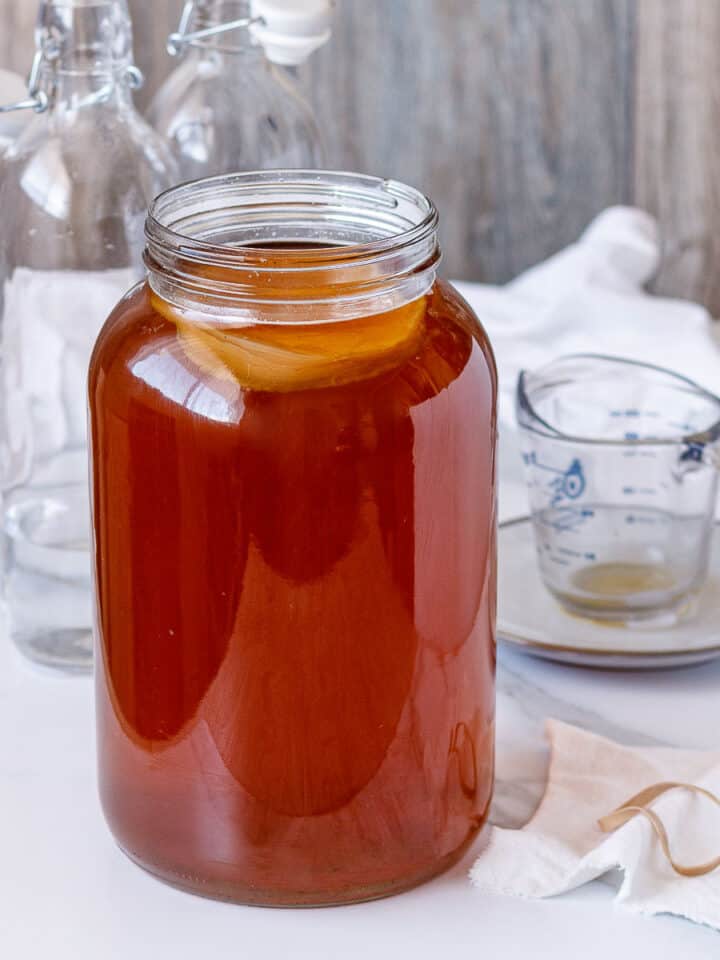
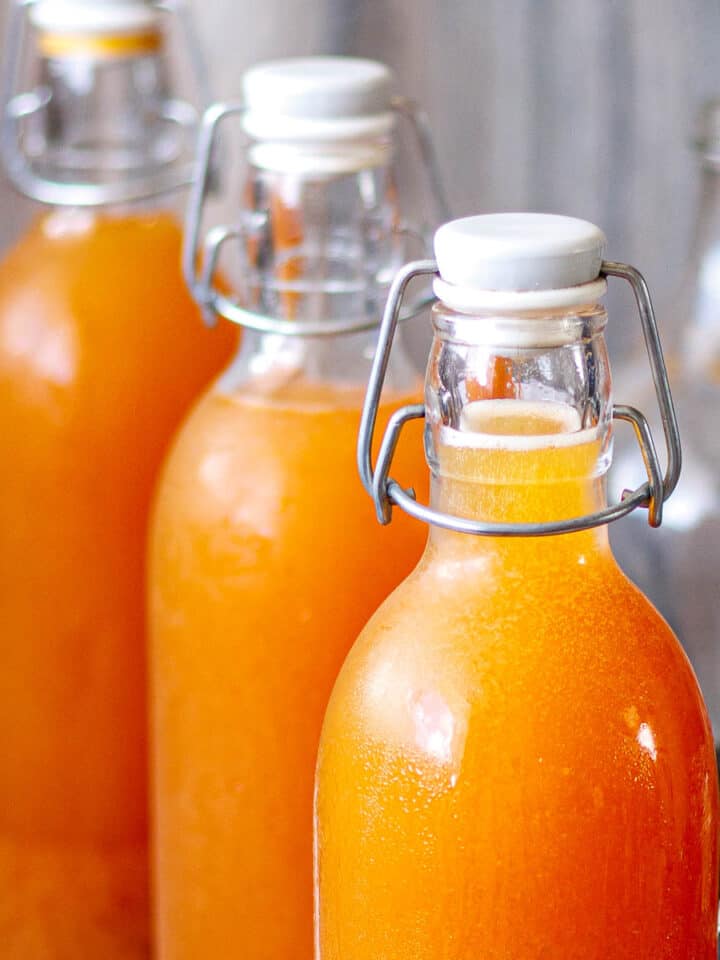
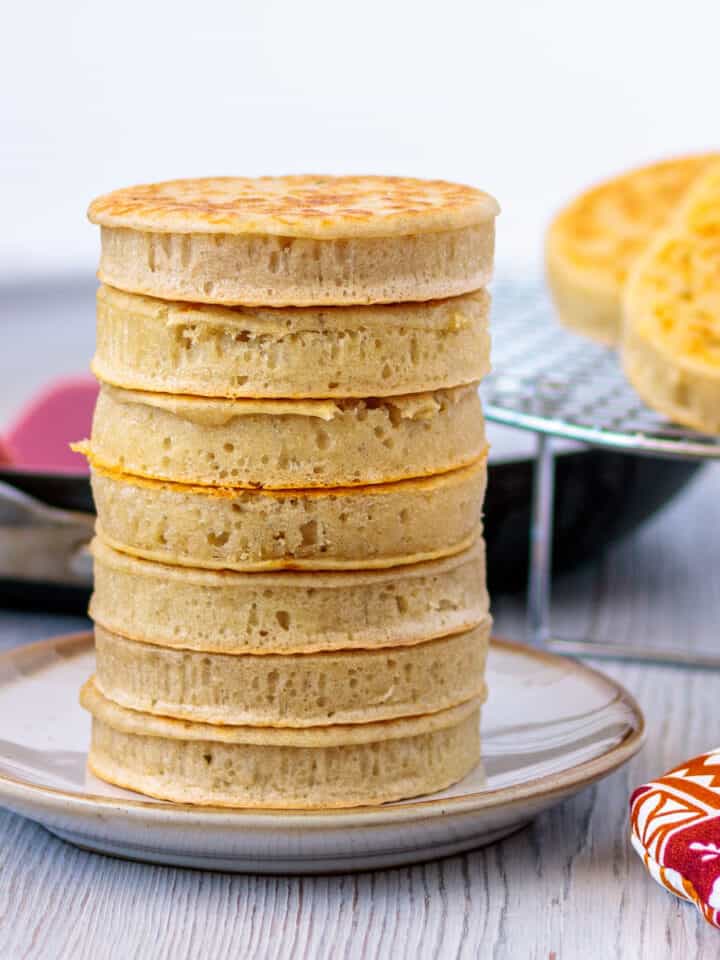
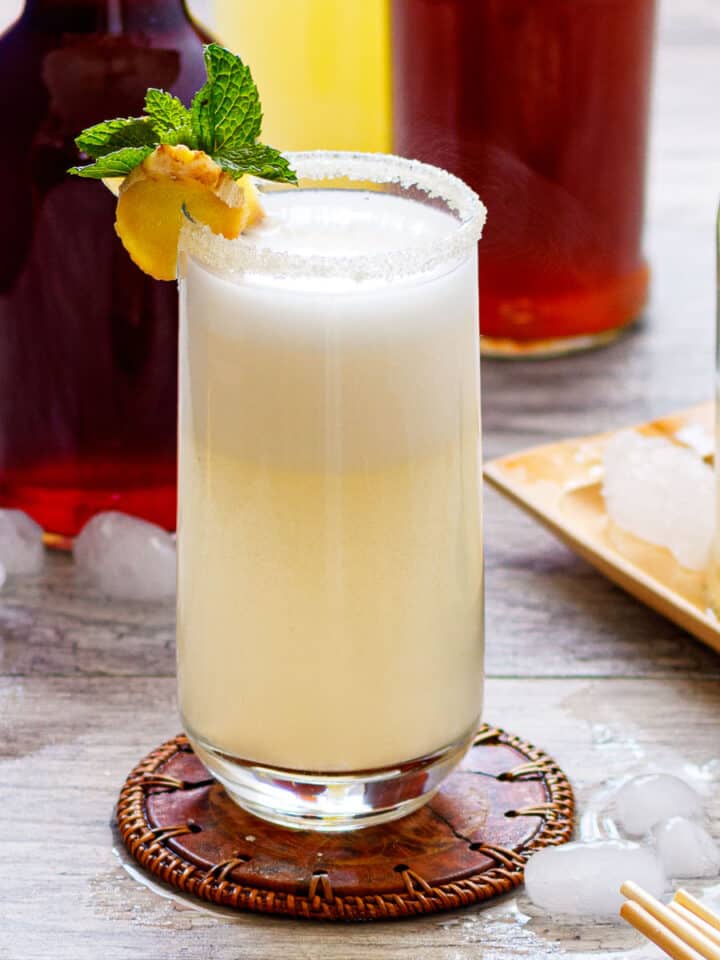
Franzi
Hey, i tried making the ginger bug and realised too late that there shouldn't be a sourdough starter nearby... Actually I thought it might be beneficial.. do I need to start from scratch or can I save it somehow?
Poppy Hudson
Hello, you should be fine if the two cultures weren't too close together. The general rule of thumb is 4-5 feet apart when fermenting foods that have competing bacteria. BTW that includes things like compost, overripe fruit or unclean utensils. I say proceed and good luck!
Manuel
Hi Poppy,
Thanks a lot for your recipe.
My last two ginger bugs become moldy after some weeks. Probably because the recipe I used did not mention to remove all old ginger from the bug. And it floated above the bug and got to much air.
(The bug was in the refrigerator, and only about 2 weeks old)
What is important to avoid mold?
Best regards
Poppy Hudson
Auuwe, that's disappointing. It's okay if old ginger bits float to the top of the jar, and it's fine to leave them in until you have too much accumulated. Here are the things most helpful in preventing mold: Make sure there isn't any mold on the original ginger used to start the bug, or subsequently in feedings. Inspect and clean thoroughly before chopping it up and leave the skin on. Use bleach if necessary to wash your knives and jars, and rinse thoroughly with clean water. Make sure there isn't any moldy fruit in the refrigerator where you store the ginger bug. Hope this helps and paves the way for more soda!
Rose
On the 2nd & 3rd day I saw bubbles on the surface, but the next following days I did not see any bubble but it smells a lil yeasty/sour, has itgone bad? Today is on the 6th day. And I’m using ginger that is being store in the fridge
Poppy Hudson
Aloha Rose, not necessarily bad. A mild, yeasty and slightly sour smell is appropriate, and bubbles on the 2nd and 3rd day are excellent! I think you may have a fine, healthy culture. No problem with ginger stored in the refrigerator. I'm thinking you're ready to brew soda. Let me know how it goes!
Sarina Barba
I'm on the 6th day. Followed everything on the post and I'm not seeing bubbles
Poppy Hudson
Hello Sarina, How warm is your climate? If it is too cold, it may take longer. You can try waiting a bit. Be sure to read the full section of the post titled "When is it ready?" for tips. Also, the FAQ section answering "Why won't my ginger bug ferment?". There is a learning curve with growing a ginger bug. Hang in there - I'm cheering you on. Aloha
Angie Jones
If I chop/great all of my Ginger and store it in the fridge for feedings, how long is that ginger good for before I have to buy some fresh?
Poppy Hudson
Hello Angie. Once the ginger is chopped, it will remain fresh for 5-7 days. If it is grated it will only last 3-4 days. Typically the uncut, whole root with the peel on will be good for 2-3 weeks.
Joe
What measurement is a TB?
Poppy Hudson
Thank you, Joe, for your question. I have updated the recipe and replaced the abbreviation "TB" with tablespoon. That's your measurement!
Alyssa
I have been following this recipe for 5 days so mine is almost ready! My question is how do I know how much juice to add? And do I let it sit for longer after adding juice to “brew”? I was thinking of adding blueberry lime
Poppy Hudson
Hello. You can check out my Ginger Bug Soda Recipes for answers to your questions. Your blueberry and lime version sounds delicious. However, regular blueberry juice is not as intense as the frozen concentrated juice in my recipes, so you'll need to make adjustments for a blueberry variation. You might try using the elderberry soda recipe and substitute 6 TB of dried blueberries for the elderberries and lime juice for the lemon juice. Please note you need 1/2 cup to 3/4 cup sugar in most recipes to get a sweet and bubbly soda. Let me know how it goes!
Olive Caban
Could you please clarify what TB stands for?
Poppy Hudson
Yes, TB stands for tablespoon. Thanks for asking; I have considered spelling it out in future posts. Aloha.
Prem and Casey
Hey Poppy, Its Prem and Casey from Maui. We miss you! We just made our first ginger bug and bottled 2 gallons of ginger soda with it. Very exciting. Thank you!
Poppy Hudson
Aloha!!! What sweet news to kick off the New Year. Enjoy! 🩷🌈🏝
Donna
I love ginger! Can I grate the ginger instead of chopping so I can have a stronger, spicier flavor?
Poppy Hudson
Absolutely!